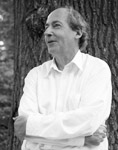
© G. Bompais
Ruines, clartes stellaires (Ruins, stellar brightness)
Homage to Berlioz? Why did I feel concerned by this appeal? Probably because Berlioz, but most of all music from the first half of the 19th century, were at the source of my decision to compose, a territory in which I found myself and that Berlioz and his era stay for me like a refuge when I feel like music - grace - eludes me.
But an homage must not be a pastiche or a parody or a series of quotations. I think it is more a case of being able to find in your own language something from the composer's spirit, in the present case being able to evoke Berlioz's violent contrasts and abrupt sincerity, his tone breaks, also his elegiac nature showing through his long melodic lines, his sense of timbres and orchestra, his 'ninitive' activations to quote him. Also having his demands towards musicians, to whom Berlioz often asks the maximum. I have to admit I totally follow his example…
There is another composer I evoked in "Ruines, clartes stellaires": Schumann. Although his withdrawn nature seems remote from the volcanic - but also depressed - energy of Berlioz, Schumann was amongst the composers from this era the one who best understood Berlioz, having done one of the brightest and deepest analysis of the 'Fantastic'. That's why the Schumannian ghost hangs around in these pages, but in a totally contemporary language.
The piece "Ruines, clartes stellaires" is written in two parts separated by a silence of about twenty seconds. This silence is not a break but more a hyphenation, a big breath between each movement. The first one, 'Ruines', is like a distant reflection of the Fantastic Symphony. The clarinet solo's role is at the same time violent and ironic, the trombone is like a call and most of all tutti comes back three times like a big orchestra. Its writing in 'modes of limited transposition' heightens its obsessive aspect. The end of the movement in big cresendo, with a double bass and snare drum ostinato, is a transient allusion to 'March To The Torture'. The alternation of very simple builds (4/4 time) and others more complex heighten the worried impression that this movement gives.
The second movement, 'Clartes stellaires', is like a 'revisited tradition' of all the nocturnal music from the 19th but also the 20th century: Berlioz of course, but also Schumann, Chopin, Bartók, Kurtag, Boucourechliev. Its writing is very melodic, almost tonal: the timbres are not simple 'colouring' of this melody but are often part of the primitive inspiration. This melodic line, interrupted by a trumpet call and double bass pizzicatos, carries on with a big crescendo on a unique chord repeated numerous times, and ends with an appeasement where can be heard the only piece's 'quotation' taken from the first movement of Schumann's Fantasy for Piano, a movement he wanted to call 'Ruins'… This is how this piece ends, homage to Berlioz of course but most of all a piece where I tried to evoke these speaking and familiar shadows…Audio sample: performed by "LE TEMPS RETROUVE" ensemble - Jean Michel Danet, violin - Dominique Rochet, double bass - Géraldine Scotto, flutes - Bernard Bonhomme, clarinet - Wendelin Serwe, bassoon - Jean Pierre Gonsalvès, trumpet and cornet - Anne Boussard, horn - Joel Castaingts, trombone - Reanud d'Ham, percussions -
Serge Coste conductor.